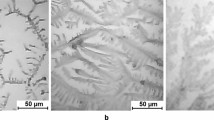Abstract
THE experiments of J. Loeb (“Proteins and the Theory of Colloidal Behavior”, New York, 1922) have shown that the iso-electric point of amphoteric substances is readily determined by staining them with basic or acidic ions or dyes at known hydrogen-ion concentrations. The method has since been applied for the determination of the iso-electric point of the mycelium of Rhizopus (Robbins, W. J., 1924, Journ. Gen. Physiol., 6, 259) and of bacteria (Steam, E. W., and Stearn, A. E., 1924, Journ. Bacteriol., 9, 463) by staining with dyes.
This is a preview of subscription content, access via your institution
Access options
Subscribe to this journal
Receive 51 print issues and online access
$199.00 per year
only $3.90 per issue
Buy this article
- Purchase on Springer Link
- Instant access to full article PDF
Prices may be subject to local taxes which are calculated during checkout
Similar content being viewed by others
Author information
Authors and Affiliations
Rights and permissions
About this article
Cite this article
PANTIN, C., ROGERS, T. An Amphoteric Substance in the Radula of the Whelk (Buccinum undatum). Nature 115, 639–640 (1925). https://doi.org/10.1038/115639b0
Issue Date:
DOI: https://doi.org/10.1038/115639b0
Comments
By submitting a comment you agree to abide by our Terms and Community Guidelines. If you find something abusive or that does not comply with our terms or guidelines please flag it as inappropriate.



